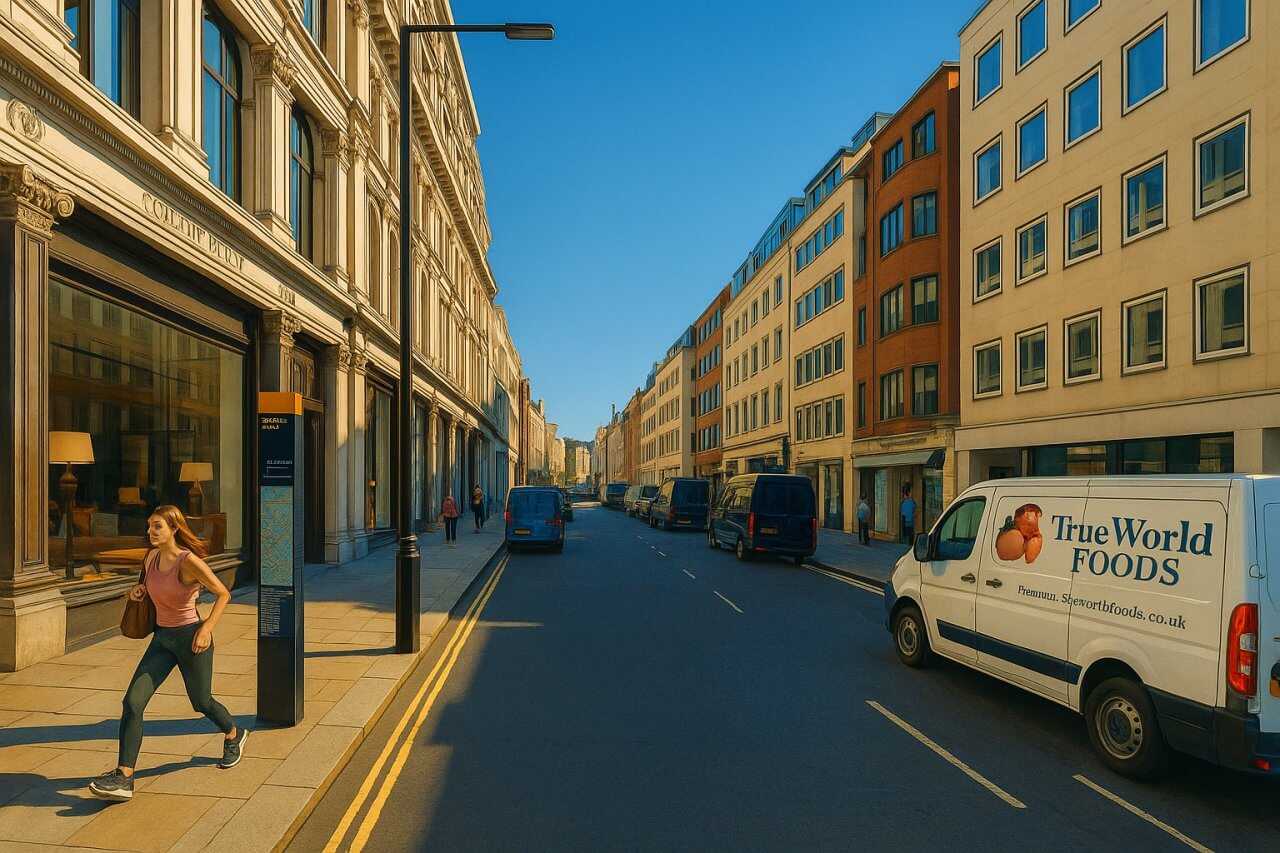
Conduit Street, London
Meta description: Conduit Street in Mayfair links Regent Street to New Bond Street, known for its fine fashion, history, and proximity to Savile Row and Oxford Circus.
Introduction
Conduit Street is a short but historically significant street in the City of Westminster, central London. It connects the celebrated Regent Street at its northeastern end with New Bond Street and Bruton Street to the southwest. Branching off Conduit Street are notable roads such as Savile Row, Mill Street, and St George Street, placing it right in the heart of fashionable Mayfair.
Route, Length, and Traffic
Conduit Street measures approximately 300 metres (985 feet) in length and runs in a one-way direction from east to west, beginning at Regent Street and ending at the junction with Bruton Street and New Bond Street. The street accommodates narrow pavements and two lanes of vehicular traffic heading westward. It is frequently busy with both taxis and delivery vehicles servicing the area’s numerous high-end boutiques and offices.
Origin of the Name and Pronunciation
The name “Conduit Street” originates from a water conduit that once stood near what is now Conduit Street and Bruton Street. It was constructed in the early 17th century to supply fresh water to the rapidly growing area of Westminster. The word “conduit” refers to a channel or pipe used to transport water or other fluids.
The name is pronounced as CON-dit (/ˈkɒndɪt/)  , with emphasis on the first syllable and a silent 'u'.
, with emphasis on the first syllable and a silent 'u'.
History
Conduit Street was laid out during the development of Mayfair in the late 17th and early 18th centuries. It first appears in historical records around 1705 and was built to serve the elite neighbourhood then rising in what was once open countryside. The area quickly attracted aristocrats, merchants, and later fashion houses, laying the foundation for its present-day character as a prestigious street.
Over the centuries, the street evolved in step with Mayfair’s development, gradually becoming a hub for bespoke tailors, luxury brands, and creative industries. Though less famous than its neighbours, Conduit Street retains a quieter elegance reflective of its long-standing refinement.
Character and Ambience
Conduit Street has an understated, refined atmosphere typical of the West End's most exclusive pockets. The architecture is a mix of Georgian and Edwardian styles, with several buildings listed for their historical and aesthetic value. While foot traffic is less dense than on nearby thoroughfares, it is frequented by those in the know—art buyers, fashion clients, and city professionals.
Unlike larger commercial arteries, Conduit Street exudes a more discreet charm, with high-end showrooms and members’ clubs occupying its upper floors. The street is especially popular with those seeking a quieter luxury shopping experience compared to the busier Regent Street or Piccadilly.
Notable Sights and Nearby Attractions
Though Conduit Street itself is modest in length, its proximity to many key London sights makes it a well-positioned destination. Nearby attractions include:
- Regent Street: World-renowned shopping boulevard with flagship stores and seasonal light displays.
- Savile Row: Just around the corner, this street is legendary for its bespoke tailoring tradition.
- Royal Academy of Arts: A few blocks south near Piccadilly, hosting major exhibitions and events.
- Berkeley Square: A short walk away, one of Mayfair’s most iconic green spaces.
Conduit Street is also home to prestigious establishments such as the Westbury Hotel (now undergoing redevelopment), as well as designer fashion showrooms, especially catering to the luxury market.
Real Estate and Property Values
As of early 2025, property prices on Conduit Street remain among the highest in the Westminster area. Commercial spaces, particularly those suitable for retail or boutique offices, can command between £2,500 and £4,500 per sq ft (£26,910–£48,440 per sq m), depending on frontage and interior condition.
Residential accommodation on or immediately near Conduit Street is scarce, but nearby apartments in converted period buildings average £2,200–£3,000 per sq ft (£23,680–£32,290 per sq m). These rates significantly exceed the London average, reflecting both the exclusivity and centrality of the Mayfair location.
Transport and Accessibility
Conduit Street is well-connected by London Underground services and buses. The nearest London Underground stations include:
- Oxford Circus Station – served by the Bakerloo Line, Victoria Line, and Central Line.
- Bond Street Station – served by the Jubilee and Central lines, as well as the Elizabeth line.
- Green Park Station – connects to the Jubilee Line, Piccadilly Line, and Victoria Line.
Nearby bus stops along Regent Street and Oxford Street serve numerous routes including the 22, 55, 73, 137, and 390, providing easy access to St James's, the City, and the West End.
Fun Fact
Conduit Street once hosted the London headquarters of the prominent Art Nouveau architect Charles Rennie Mackintosh, whose influence can still be seen in the decorative design of select facades. His work for the firm Waring & Gillow left a lasting mark on the street’s artistic history.
Quick Facts
- Location: Mayfair, City of Westminster
- Length: Approx. 300m (985ft)
- Traffic Direction: One-way, east to west
- Name Origin: Named after a 17th-century water conduit
- Pronunciation: /ˈkɒndɪt/
- Nearby Streets: Regent Street, New Bond Street, Savile Row
- Nearby Attractions: Royal Academy of Arts, Berkeley Square
- Underground Stations: Oxford Circus, Bond Street, Green Park
- Bus Routes: Served via Regent Street and Oxford Street
- Real Estate: Commercial £2,500–£4,500 per sq ft (as of 2025)
Map of Conduit Street, London

Painting of Conduit Street, London (View image in full size)